section 4 RENAULT CLIO 2009 X85 / 3.G Owners Manual
[x] Cancel search | Manufacturer: RENAULT, Model Year: 2009, Model line: CLIO, Model: RENAULT CLIO 2009 X85 / 3.GPages: 264, PDF Size: 15.68 MB
Page 5 of 264
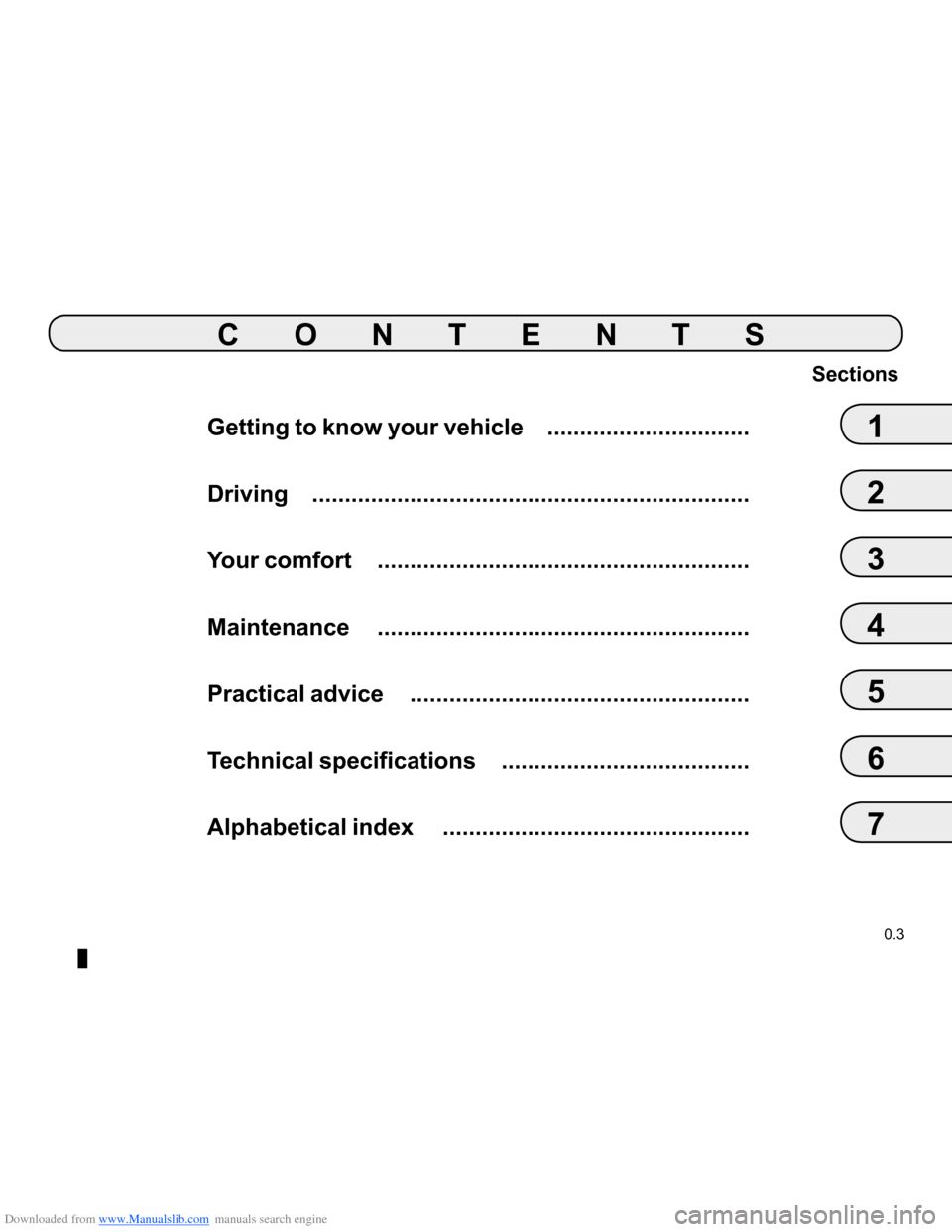
Downloaded from www.Manualslib.com manuals search engine
0.3
ENG_UD10503_1Sommaire Général (X85 - B85 - C85 - S85 - K85 - Renault)ENG_NU_853-3_BCSK85_Renault_0
Getting to know your vehicle ...............................
Driving
...................................................................
Your comfort .........................................................
Maintenance .........................................................
Practical advice ....................................................
Technical specifications ......................................
Alphabetical index ...............................................
Sections
1
C O N T E N T S
2
3
4
5
6
7
Page 7 of 264
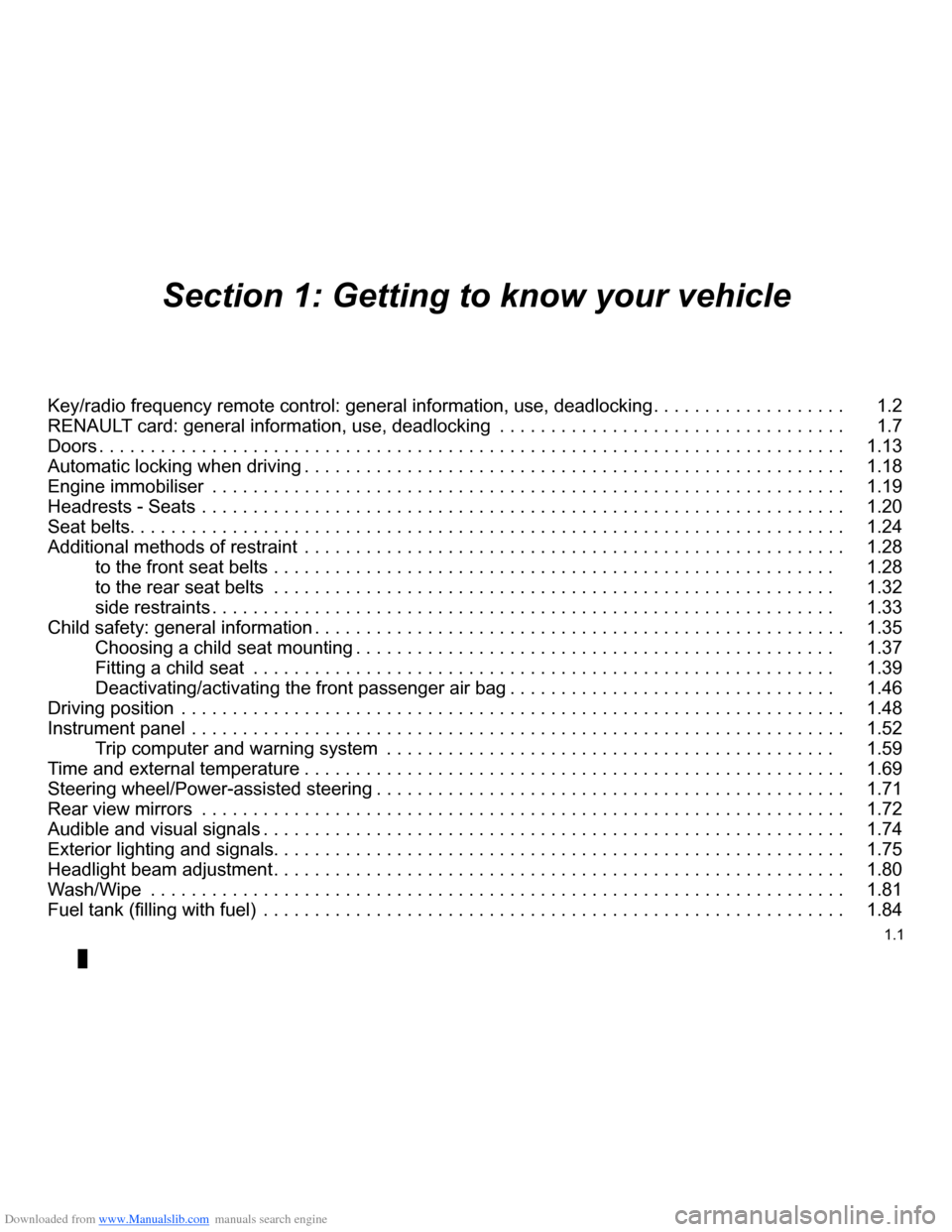
Downloaded from www.Manualslib.com manuals search engine
1.1
ENG_UD14656_4Sommaire 1 (X85 - B85 - C85 - S85 - K85 - Renault)ENG_NU_853-3_BCSK85_Renault_1
Section 1: Getting to know your vehicle
Key/radio frequency remote control: general information, use, deadlockin\
g . . . . . . . . . . . . . . . . . . . 1.2
RENAULT card: general information, use, deadlocking . . . . . . . . . . . . . . . . . . . . . . . . . . . . . . . . . . 1.7
Doors . . . . . . . . . . . . . . . . . . . . . . . . . . . . . . . . . . . . \
. . . . . . . . . . . . . . . . . . . . . . . . . . . . . . . . . . . . \
. 1.13
Automatic locking when driving . . . . . . . . . . . . . . . . . . . . . . . . . . . . . . . . . . . . \
. . . . . . . . . . . . . . . . . 1.18
Engine immobiliser . . . . . . . . . . . . . . . . . . . . . . . . . . . . . . . . . . . .\
. . . . . . . . . . . . . . . . . . . . . . . . . . 1.19
Headrests - Seats . . . . . . . . . . . . . . . . . . . . . . . . . . . . . . . . . . . .\
. . . . . . . . . . . . . . . . . . . . . . . . . . . 1.20
Seat belts. . . . . . . . . . . . . . . . . . . . . . . . . . . . . . . . . . . . \
. . . . . . . . . . . . . . . . . . . . . . . . . . . . . . . . . . 1.24
Additional methods of restraint . . . . . . . . . . . . . . . . . . . . . . . . . . . . . . . . . . . .\
. . . . . . . . . . . . . . . . . 1.28
to the front seat belts . . . . . . . . . . . . . . . . . . . . . . . . . . . . . . . . . . . .\
. . . . . . . . . . . . . . . . . . . 1.28
to the rear seat belts . . . . . . . . . . . . . . . . . . . . . . . . . . . . . . . . . . . .\
. . . . . . . . . . . . . . . . . . . 1.32
side restraints . . . . . . . . . . . . . . . . . . . . . . . . . . . . . . . . . . . . \
. . . . . . . . . . . . . . . . . . . . . . . . . 1.33
Child safety: general information . . . . . . . . . . . . . . . . . . . . . . . . . . . . . . . . . . . . \
. . . . . . . . . . . . . . . . 1.35
Choosing a child seat mounting . . . . . . . . . . . . . . . . . . . . . . . . . . . . . . . . . . . . \
. . . . . . . . . . . 1.37
Fitting a child seat . . . . . . . . . . . . . . . . . . . . . . . . . . . . . . . . . . . .\
. . . . . . . . . . . . . . . . . . . . . 1.39
Deactivating/activating the front passenger air bag . . . . . . . . . . . . . . . . . . . . . . . . . . . . . . . . 1.46
Driving position . . . . . . . . . . . . . . . . . . . . . . . . . . . . . . . . . . . .\
. . . . . . . . . . . . . . . . . . . . . . . . . . . . . 1.48
Instrument panel . . . . . . . . . . . . . . . . . . . . . . . . . . . . . . . . . . . .\
. . . . . . . . . . . . . . . . . . . . . . . . . . . . 1.52
Trip computer and warning system . . . . . . . . . . . . . . . . . . . . . . . . . . . . . . . . . . . .\
. . . . . . . . 1.59
Time and external temperature . . . . . . . . . . . . . . . . . . . . . . . . . . . . . . . . . . . . \
. . . . . . . . . . . . . . . . . 1.69
Steering wheel/Power-assisted steering . . . . . . . . . . . . . . . . . . . . . . . . . . . . . . . . . . . . \
. . . . . . . . . . 1.71
Rear view mirrors . . . . . . . . . . . . . . . . . . . . . . . . . . . . . . . . . . . .\
. . . . . . . . . . . . . . . . . . . . . . . . . . . 1.72
Audible and visual signals . . . . . . . . . . . . . . . . . . . . . . . . . . . . . . . . . . . . \
. . . . . . . . . . . . . . . . . . . . . 1.74
Exterior lighting and signals. . . . . . . . . . . . . . . . . . . . . . . . . . . . . . . . . . . . \
. . . . . . . . . . . . . . . . . . . . 1.75
Headlight beam adjustment . . . . . . . . . . . . . . . . . . . . . . . . . . . . . . . . . . . . \
. . . . . . . . . . . . . . . . . . . . 1.80
Wash/Wipe . . . . . . . . . . . . . . . . . . . . . . . . . . . . . . . . . . . .\
. . . . . . . . . . . . . . . . . . . . . . . . . . . . . . . . 1.81
Fuel tank (filling with fuel) . . . . . . . . . . . . . . . . . . . . . . . . . . . . . . . . . . . .\
. . . . . . . . . . . . . . . . . . . . . 1.84
Page 9 of 264
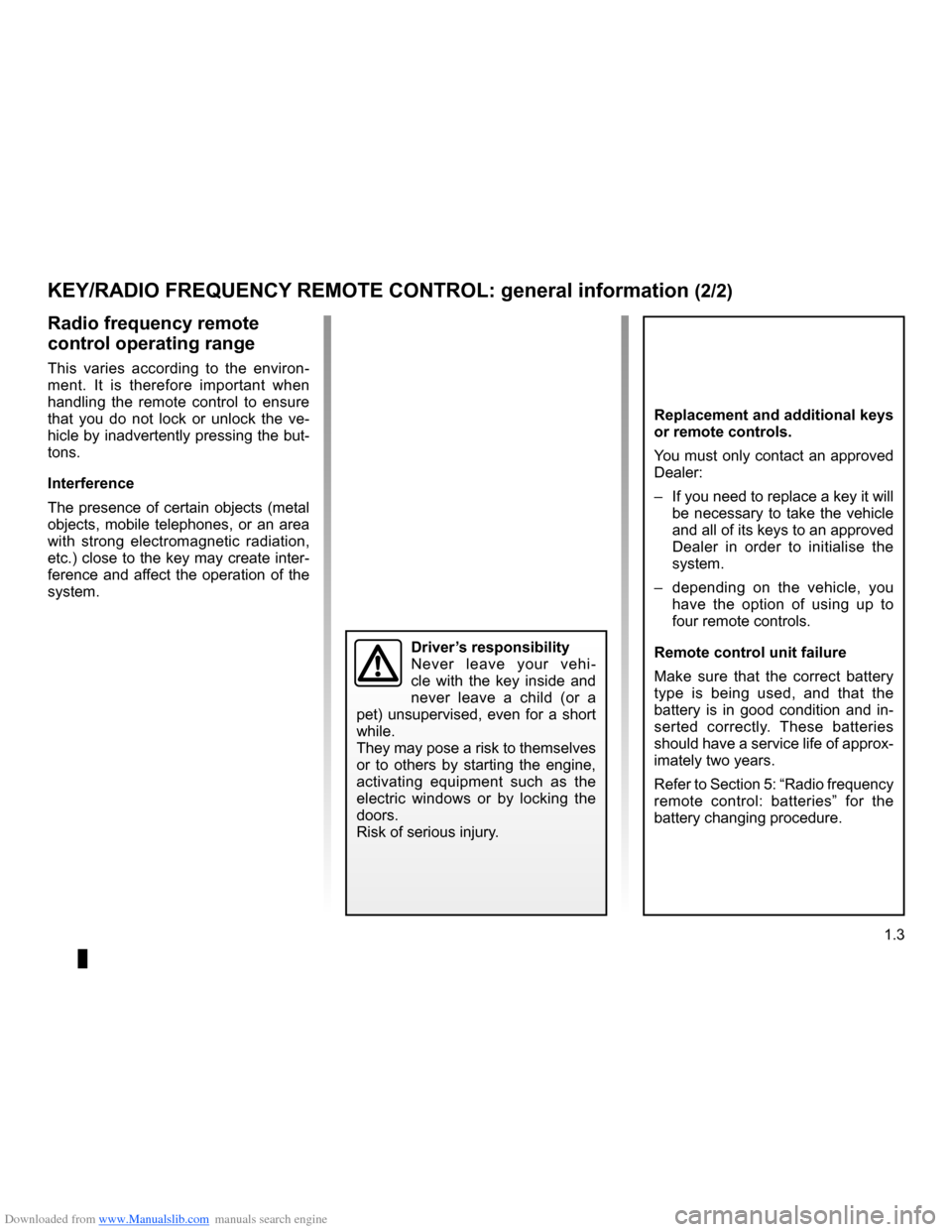
Downloaded from www.Manualslib.com manuals search engine
JauneNoirNoir texte
1.3
ENG_UD14657_2Clé / télécommande à radiofréquence : généralité\
s (X85 - B85 - C85 - S85 - K85 - Renault)ENG_NU_853-3_BCSK85_Renault_1
KEY/RADIO FREQUENCY REMOTE CONTROL: general information (2/2)
Driver’s responsibilityNever leave your vehi- cle with the key inside and never leave a child (or a pet) unsupervised, even for a short while.They may pose a risk to themselves or to others by starting the engine, activating equipment such as the electric windows or by locking the doors.Risk of serious injury.
Radio frequency remote
control operating range
This varies according to the environ- ment. It is therefore important when handling the remote control to ensure that you do not lock or unlock the ve- hicle by inadvertently pressing the but- tons.
Interference
The presence of certain objects (metal objects, mobile telephones, or an area
with strong electromagnetic radiation, etc.) close to the key may create inter- ference and affect the operation of the system.
Replacement and additional keys or remote controls.
You must only contact an approved Dealer:
– If you need to replace a key it will
be necessary to take the vehicle and all of its keys to an approved Dealer in order to initialise the system.
– depending on the vehicle, you
have the option of using up to four remote controls.
Remote control unit failure
Make sure that the correct battery type is being used, and that the battery is in good condition and in- serted correctly. These batteries should have a service life of approx- imately two years.
Refer to Section 5: “Radio frequency remote control: batteries” for the battery changing procedure.
Page 13 of 264
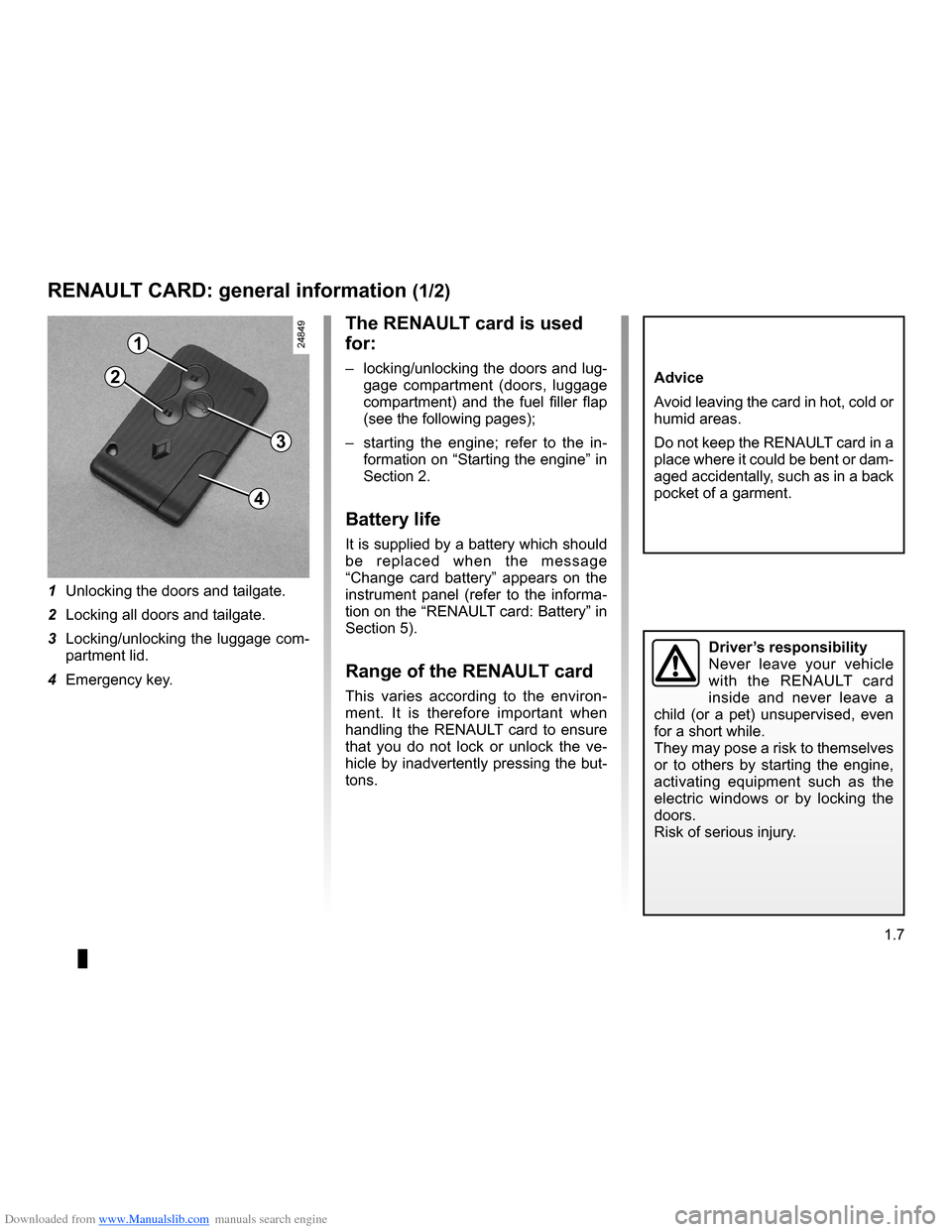
Downloaded from www.Manualslib.com manuals search engine
RENAULT carduse ..................................................(up to the end of the DU)doors/tailgate ........................................(up to the end of the DU)locking the doors ..................................(up to the end of the DU)children ..................................................................(current page)
1.7
ENG_UD10511_1Cartes Renault : généralités (X85 - B85 - C85 - S85 - K85 - Re\
nault)ENG_NU_853-3_BCSK85_Renault_1
RENAULT card: general information, use, deadlocking
The RENAULT card is used
for:
– locking/unlocking the doors and lug- gage compartment (doors, luggage compartment) and the fuel filler flap (see the following pages);
– starting the engine; refer to the in
- formation on “Starting the engine” in Section 2.
Battery life
It is supplied by a battery which should be replaced when the message “Change card battery” appears on the instrument panel (refer to the informa- tion on the “RENAULT card: Battery” in Section 5).
Range of the RENAULT card
This varies according to the environ- ment. It is therefore important when handling the RENAULT card to ensure that you do not lock or unlock the ve- hicle by inadvertently pressing the but- tons.
1 Unlocking the doors and tailgate.
2 Locking all doors and tailgate.
3 Locking/unlocking the luggage com- partment lid.
4 Emergency key.
RENAULT CARD: general information (1/2)
2
1
3
4
Driver’s responsibilityNever leave your vehicle with the RENAULT card inside and never leave a child (or a pet) unsupervised, even for a short while.They may pose a risk to themselves or to others by starting the engine, activating equipment such as the electric windows or by locking the doors.Risk of serious injury.
Advice
Avoid leaving the card in hot, cold or humid areas.
Do not keep the RENAULT card in a place where it could be bent or dam- aged accidentally, such as in a back pocket of a garment.
Page 25 of 264

Downloaded from www.Manualslib.com manuals search engine
engine immobiliser................................(up to the end of the DU)engine immobiliser................................(up to the end of the DU)
1.19
ENG_UD10518_1Système antidémarrage (X85 - B85 - C85 - S85 - K85 - Renault)ENG_NU_853-3_BCSK85_Renault_1
Engine immobiliser
Operating fault warning light
If the warning light continues to flash or stays lit up permanently following an at- tempt to start the engine, this indicates a fault in the system.
In this case, use the second key or card (supplied with the vehicle). If the fault is still present, contact an approved Dealer, as they are the only personnel qualified to repair the engine immobi- liser system.
If there is interference and/or the hands- free RENAULT card is not recognised, move the card or insert it fully into the card reader.Vehicle protection tell-tale
light
After the ignition has been switched off, warning light 1 flashes and the vehicle is protected.
This prevents anyone not in posses- sion of the vehicle’s coded ignition key or card from starting the engine.
Operating principle
When the engine is started, warning
light 1 remains lit for a few seconds then goes out (refer to the information on “Starting the engine” in Section 2).
The vehicle is automatically protected a few seconds after the engine is switched off.
ENGINE IMMOBILISER
1
Any unauthorised work
carried out on the engine immobiliser (computers, wiring, etc.) could be dan- gerous. Work must be carried out by qualified personnel.
Page 30 of 264
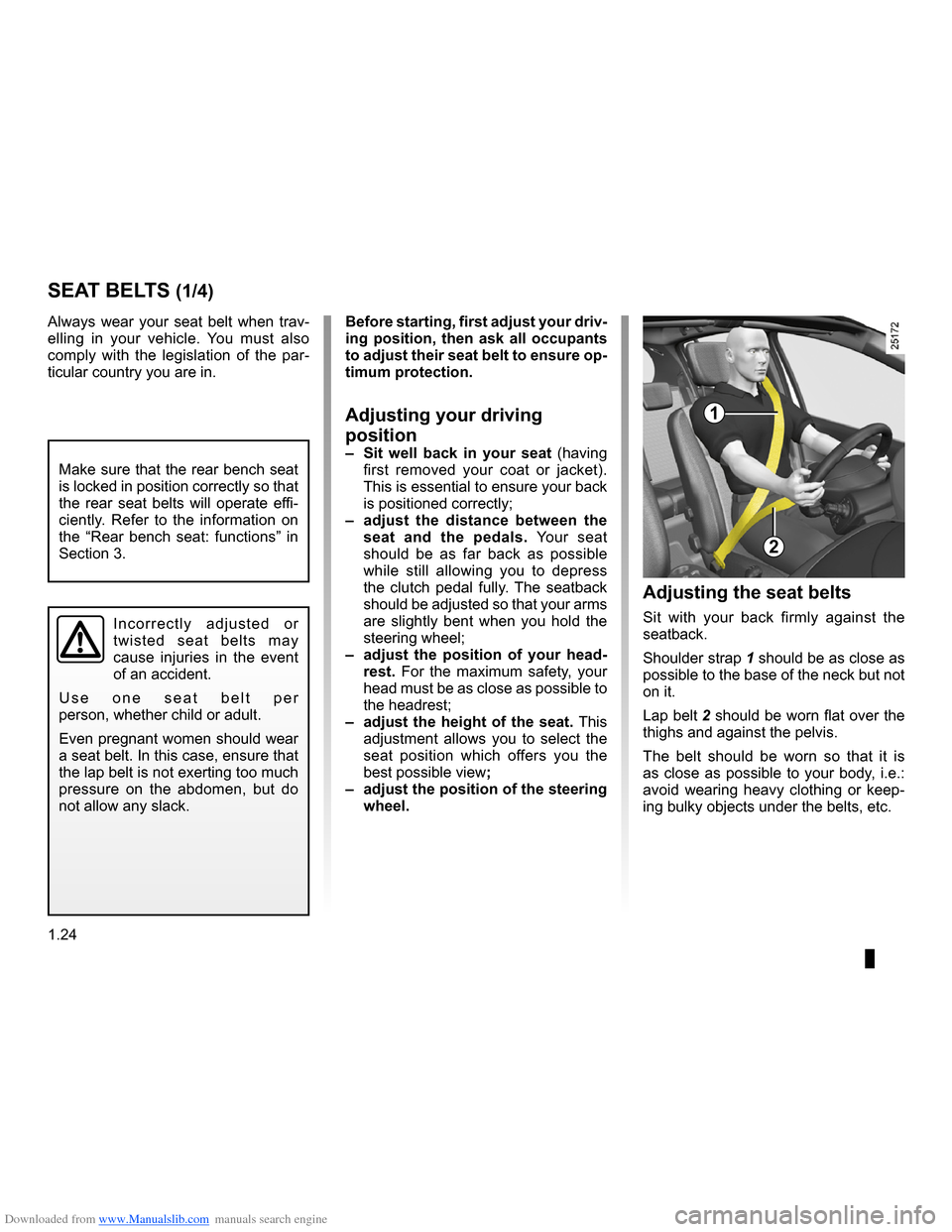
Downloaded from www.Manualslib.com manuals search engine
seat belts ..............................................(up to the end of the DU)adjusting your driving position ..............(up to the end of the DU)front seatsadjustment .......................................................(current page)driving positionsettings ...........................................(up to the end of the DU)
1.24
ENG_UD14660_3Ceintures de sécurité (X85 - B85 - C85 - S85 - K85 - Renault)ENG_NU_853-3_BCSK85_Renault_1
JauneNoirNoir texte
Always wear your seat belt when trav- elling in your vehicle. You must also comply with the legislation of the par- ticular country you are in.
Seat belts
SEAT BELTS (1/4)
1
2
I n c o r r e c t l y a d j u s t e d o r twisted seat belts may cause injuries in the event of an accident.
U s e o n e s e a t b e l t p e r person, whether child or adult.
Even pregnant women should wear
a seat belt. In this case, ensure that the lap belt is not exerting too much pressure on the abdomen, but do not allow any slack.
Before starting, first adjust your driv- ing position, then ask all occupants to adjust their seat belt to ensure op- timum protection.
Adjusting your driving
position– Sit well back in your seat (having first removed your coat or jacket). This is essential to ensure your back is positioned correctly;
– adjust the distance between the seat and the pedals. Your seat should be as far back as possible while still allowing you to depress the clutch pedal fully. The seatback should be adjusted so that your arms are slightly bent when you hold the steering wheel;
– adjust the position of your head- rest. For the maximum safety, your head must be as close as possible to the headrest;
– adjust the height of the seat. This adjustment allows you to select the
seat position which offers you the best possible view;– adjust the position of the steering wheel.
Adjusting the seat belts
Sit with your back firmly against the seatback.
Shoulder strap
1 should be as close as possible to the base of the neck but not on it.
Lap belt
2 should be worn flat over the thighs and against the pelvis.
The belt should be worn so that it is as close as possible to your body, i.e.: avoid wearing heavy clothing or keep- ing bulky objects under the belts, etc.
Make sure that the rear bench seat is locked in position correctly so that the rear seat belts will operate effi- ciently. Refer to the information on the “Rear bench seat: functions” in Section 3.
Page 35 of 264
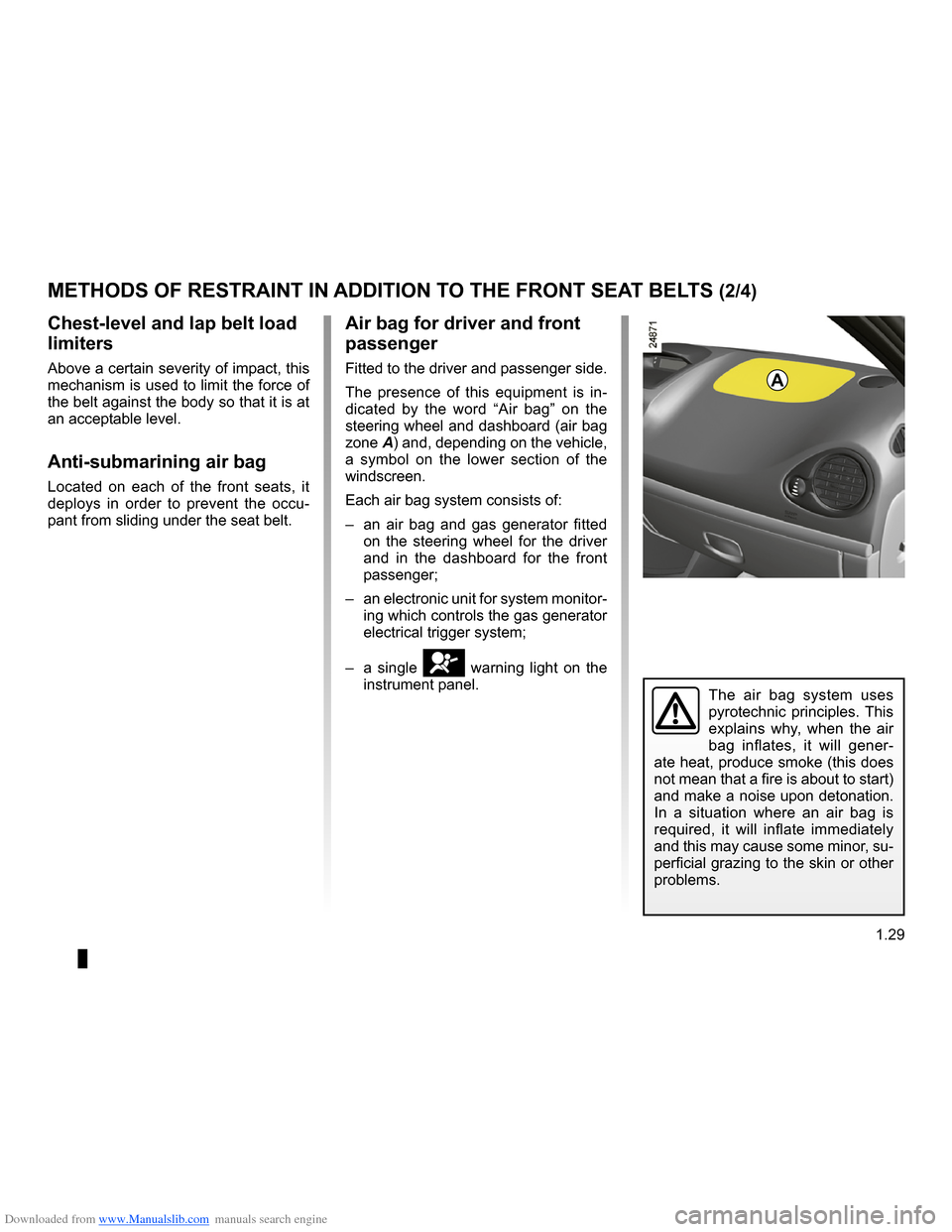
Downloaded from www.Manualslib.com manuals search engine
JauneNoirNoir texte
1.29
ENG_UD14662_2Dispositifs complémentaires à la ceinture avant (X85 - B85 - C85 \
- S85 - K85 - Renault)ENG_NU_853-3_BCSK85_Renault_1
Chest-level and lap belt load
limiters
Above a certain severity of impact, this mechanism is used to limit the force of the belt against the body so that it is at an acceptable level.
Anti-submarining air bag
Located on each of the front seats, it deploys in order to prevent the occu- pant from sliding under the seat belt.
Air bag for driver and front
passenger
Fitted to the driver and passenger side.
The presence of this equipment is in- dicated by the word “Air bag” on the steering wheel and dashboard (air bag
zone A) and, depending on the vehicle, a symbol on the lower section of the windscreen.
Each air bag system consists of:
– an air bag and gas generator fitted
on the steering wheel for the driver and in the dashboard for the front passenger;
– an electronic unit for system monitor
- ing which controls the gas generator electrical trigger system;
– a single
å warning light on the instrument panel.
METHODS OF RESTRAINT IN ADDITION TO THE FRONT SEAT BELTS (2/4)
A
The air bag system uses pyrotechnic principles. This explains why, when the air bag inflates, it will gener- ate heat, produce smoke (this does not mean that a fire is about to start)
and make a noise upon detonation. In a situation where an air bag is required, it will inflate immediately and this may cause some minor, su- perficial grazing to the skin or other problems.
Page 37 of 264
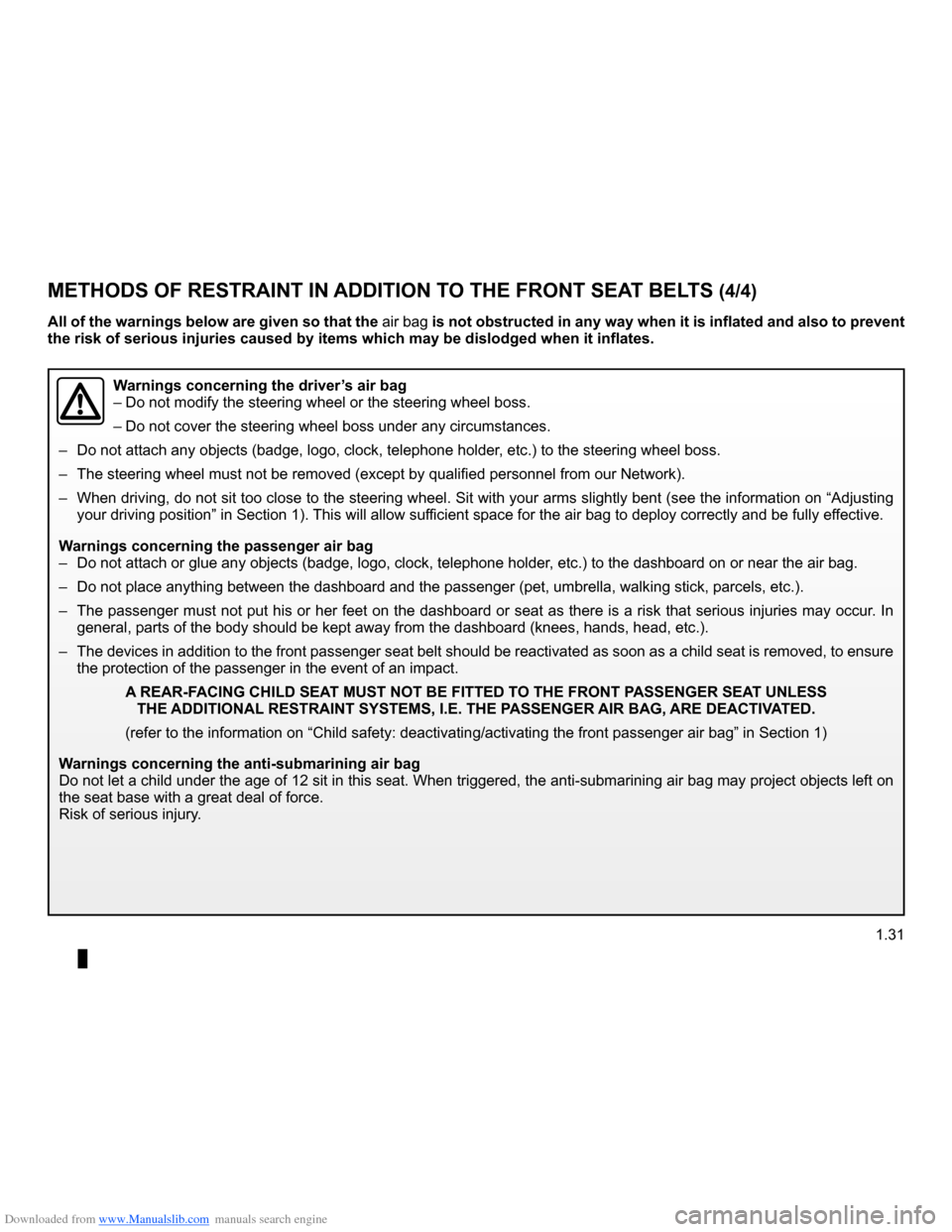
Downloaded from www.Manualslib.com manuals search engine
child safety.............................................................(current page)
JauneNoirNoir texte
1.31
ENG_UD14662_2Dispositifs complémentaires à la ceinture avant (X85 - B85 - C85 \
- S85 - K85 - Renault)ENG_NU_853-3_BCSK85_Renault_1
METHODS OF RESTRAINT IN ADDITION TO THE FRONT SEAT BELTS (4/4)
All of the warnings below are given so that the air bag is not obstructed in any way when it is inflated and also to prevent the risk of serious injuries caused by items which may be dislodged when\
it inflates.
Warnings concerning the driver’s air bag
– Do not modify the steering wheel or the steering wheel boss.
– Do not cover the steering wheel boss under any circumstances.
– Do not attach any objects (badge, logo, clock, telephone holder, etc.) to the steering wheel boss.
– The steering wheel must not be removed (except by qualified personnel from our Network).
– When driving, do not sit too close to the steering wheel. Sit with your arms slightly bent (see the information on “Adjusting
your driving position” in Section 1). This will allow sufficient space for the air bag to deploy correctly and be fully effective.
Warnings concerning the passenger air bag
– Do not attach or glue any objects (badge, logo, clock, telephone holder, etc.) to the dashboard on or near the air bag.
– Do not place anything between the dashboard and the passenger (pet, umbrella, walking stick, parcels, etc.).
– The passenger must not put his or her feet on the dashboard or seat as there is a risk that serious injuries may occur. In
general, parts of the body should be kept away from the dashboard (knee\
s, hands, head, etc.).
– The devices in addition to the front passenger seat belt should be reactivated as soon as a child seat is removed, to ensure
the protection of the passenger in the event of an impact.
A REAR-FACING CHILD SEAT MUST NOT BE FITTED TO THE FRONT PASSENGER SEAT UNLESS THE ADDITIONAL RESTRAINT SYSTEMS, I.E. THE PASSENGER AIR BAG, ARE DEACTIVATED.
(refer to the information on “Child safety: deactivating/activating \
the front passenger air bag” in Section 1)
Warnings concerning the anti-submarining air bagDo not let a child under the age of 12 sit in this seat. When triggered, the anti-submarining air bag may project objects left on the seat base with a great deal of force.Risk of serious injury.
Page 41 of 264

Downloaded from www.Manualslib.com manuals search engine
child safety............................................(up to the end of the DU)child restraint/seat ................................(up to the end of the DU)child restraint/seat ................................(up to the end of the DU)child restraint/seat ................................(up to the end of the DU)child seats.............................................(up to the end of the DU)transporting children .............................(up to the end of the DU)
1.35
ENG_UD10527_1Sécurité enfants : généralités (X85 - B85 - C85 - S85 - \
K85 - Renault)ENG_NU_853-3_BCSK85_Renault_1
Child safety: General information
Carrying children
Children, and adults, must be correctly seated and strapped in for all journeys. The children being carried in your vehi- cle are your responsibility.
A child is not a miniature adult. Children are at risk of specific injuries as their muscles and bones have not yet fin- ished growing. The seat belt alone would not provide suitable protection. Use an approved child seat and ensure you use it correctly.
CHILD SAFETY : General information
To prevent the doors being opened, use the “Child safety” device (refer to the information on “Opening a n d c l o s i n g t h e d o o r s ” i n
Section 1).
A collision at 30 mph (50 km/h) is the same as falling a distance of 10 metres. Transporting a child without a restraint is the equivalent of allow- ing him or her to play on a fourth-floor balcony without railings.Never travel with a child held in your arms. In the event of an accident, you will not be able to keep hold of the child, even if you yourself are wearing a seat belt.
If your vehicle has been involved in a road accident, replace the child seat and have the seat belts and ISOFIX anchorage points checked.
Using a child seatThe level of protection offered by the child seat depends on its ability to re- strain your child and on its installation. Incorrect installation compromises the protection it offers the child in the event of harsh braking or an impact.
Before purchasing a child seat, check that it complies with the regulations for the country you are in and that it can be fitted in your vehicle. Consult an ap- proved dealer to find out which seats are recommended for your vehicle.
Before fitting a child seat, read the manual and respect its instructions. If you experience any difficulties during installation, contact the manufacturer of the equipment. Keep the instructions with the seat.
Set a good example by always fas- tening your seat belt and teaching your child:
– to strap themselves in correctly;
– to always get in and out of the car
at the kerb, away from busy traf- fic.
Do not use a second-hand child seat or one without an instruction manual.
Check that there are no objects in the vicinity of the child seat which could impede its operation.
Never leave a child unat- tended in the vehicle.
Check that your child is always strapped in and that the belt or safety harness used is correctly set and adjusted. Avoid wearing bulky clothing which could cause the belts to slacken.
Never let your child put their head or arms out of the window.
Check that the child is in the correct position for the entire journey, espe- cially if asleep.
Page 45 of 264

Downloaded from www.Manualslib.com manuals search engine
child restraint/seat ................................(up to the end of the DU)child restraint/seat ................................(up to the end of the DU)child restraint/seat ................................(up to the end of the DU)child safety............................................(up to the end of the DU)child seats.............................................(up to the end of the DU)transporting children .............................(up to the end of the DU)
1.39
ENG_UD13297_2Sécurité enfants : installation du siège enfant (X85 - B85 - C\
85 - S85 - K85 - Renault)ENG_NU_853-3_BCSK85_Renault_1
Fitting a child seat
CHILD SAFETY : Fitting a child seat
Some seats are not suitable for fitting child seats. The diagram on the follow- ing page shows you how to attach a child seat.
The types of child seat indicated may not be available. Before using a differ- ent child seat, check with the manufac- turer that it can be fitted.
Ensure that the child seat or the child’s feet do not prevent the front seat from locking correctly. Refer to the information on the “Front seat” in Section 1.Check that when installing the child seat in the vehicle it is not at risk of coming loose from its base.If you have to remove the headrest, check that it is correctly stored so that it does not come loose under harsh braking or impact.Always attach the child seat to the
vehicle even if it is not in use so that it does not come loose under harsh braking or impact.
In the front seatThe laws concerning children travel- ling in the front passenger seat differ in every country. Consult the legislation in force and follow the indications on the diagram on the following page.
Before fitting a child seat in this seat (if authorised):
– lower the seat belt as far as possi- ble;
– move the seat as far back as possi- ble;
– gently tilt the seatback away from vertical (approximately 25°);
– on equipped vehicles, raise the seat base as far as possible.
Do not change these settings after the child seat is installed.
In the rear side seatA carrycot can be installed across the vehicle and will take up at least two seats. Position the child with his or her feet nearest the door.Move the front seat as far forward as possible to install a rear-facing child seat, then move back the seat or seats in front in accordance with the child seat instructions.For the safety of the child in the for- ward-facing seat, do not move the seat in front back past the middle of the runner, do not tilt the seatback too far (maximum of 25°) and raise the seat as much as possible.Check that the forward-facing child seat is resting against the back of the vehi- cle seat and that the headrest of the ve- hicle is not obstructing its use.
Rear centre seatCheck that the belt is suitable for se- curing your child seat. Consult an ap- proved dealer.R I S K O F D E AT H O R SERIOUS INJURY: before installing a rear-facing child seat in the front passen- ger seat, make sure the airbag has been deactivated (refer to the infor- mation on “Child safety: front pas- senger airbag deactivation/activa- tion” in Section 1).Fit the child seat in a rear seat wherever possible.